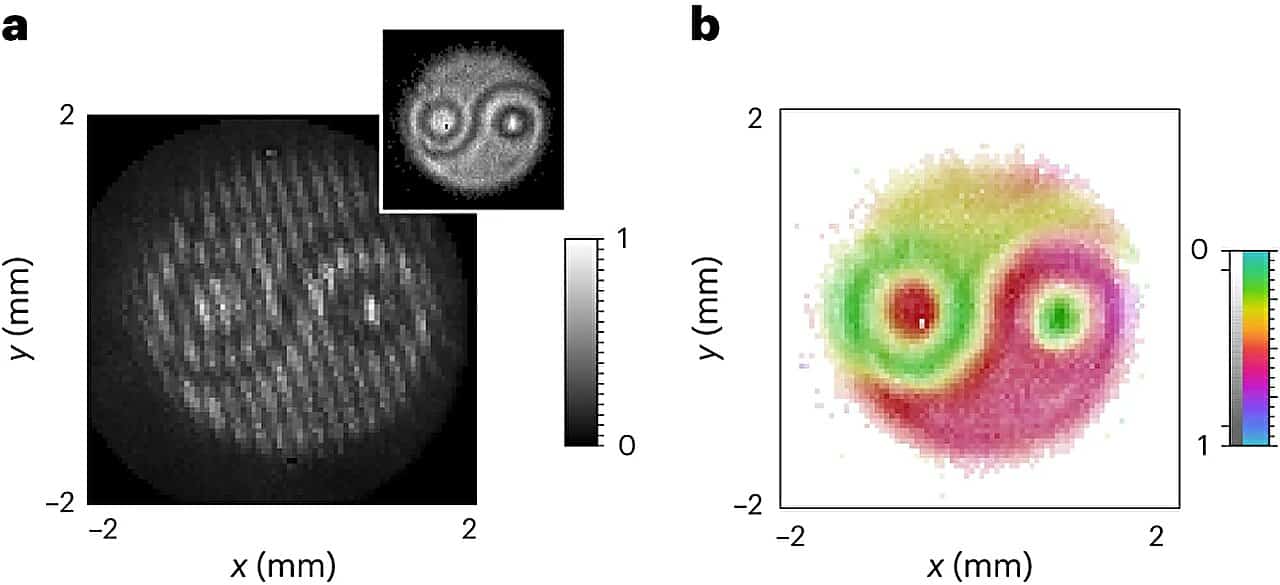
You may have heard of light as both particles and waves, but have you ever imagined the secret dance within? Researchers from the University of Ottawa and Sapienza University in Rome have just uncovered a groundbreaking technique that enables the real-time visualization of the wave function of entangled photons — the fundamental components of light.
The snapshot of a quantum dance
Imagine choosing a random shoe from a pair. If it’s a “left” shoe, you immediately know the other shoe you’ve yet to unbox is meant to go on your right foot. This instantaneous information is certain whether the shoe box is within hand’s reach or 4.3 light-years away on some planet in the Alpha Centauri system.
This analogy, though not perfect, captures the essence of quantum entanglement. At its core, quantum entanglement refers to the phenomenon where two or more particles become deeply interconnected in such a way that their properties become correlated, regardless of the spatial separation between them. This means that the state of one particle instantly influences the state of another, even if they are light-years apart.
Quantum entanglement might sound like something out of science fiction, but it’s a very real phenomenon that has been observed in experiments. It challenges our conventional understanding of how the world works and delves into the strange and wondrous realm of quantum physics, where particles can be in multiple states at once and influence each other in ways that defy our everyday intuition.
This instantaneous connection seems to defy the fundamental speed limit of information transfer imposed by Einstein’s theory of relativity. Indeed, the concept of entanglement was famously challenged by Albert Einstein, Boris Podolsky, and Nathan Rosen in a 1935 paper known as the EPR paradox. They proposed that entanglement was an incomplete description of physical reality, asserting that quantum mechanics must be missing hidden variables that determine particle properties independently.
However, subsequent experiments, notably the Bell tests, demonstrated that the EPR paradox couldn’t be resolved with classical hidden variables. The results of these experiments aligned with quantum predictions, highlighting the genuine non-local nature of entanglement.
Wave functions, crucial in quantum mechanics, can provide important insight into a particle’s quantum state. If we stick to the shoe analogy, the shoe’s “wave function” carries information like size, color, left or right, and so on. But in quantum physics, scientists usually describe a particle’s wave function in terms of position, velocity, spin, and other quantum properties.
Holography: A New Dimension of Quantum Insight
As you might imagine, determining the wave function of a quantum system is no trivial task. This process, known as quantum tomography, typically involves cumbersome measurements that introduce “dimensionality”, the number of distinct properties or characteristics that a quantum system can possess and be measured for.
In quantum mechanics, each dimension represents a distinct property that can be measured, such as position, momentum, spin, etc. When dealing with entangled particles or more complex quantum systems, the number of dimensions grows significantly. This can result in entangled systems existing in a high-dimensional space, where the dimensions correspond to various properties of the entangled particles.
Previous experiments involving quantum tomography measuring the high-dimensional quantum state of two entangled photons could take hours or even days. Not only does the process take a very long time, the quality of the results is questionable, especially for increasingly complex systems. Imagine trying to reconstruct a high-dimensional object from its shadows cast on different walls. That’s the challenge quantum scientists face when tackling quantum tomography.
But what if instead of just shadows, we have holograms? In classical optics, digital holography creates a three-dimensional image using a single interferogram — a result of light interference. The team of researchers led by Ebrahim Karimi from Ottawa University extended this concept to the realm of entangled photons.
To uncover the quantum secrets, researchers superimposed the entangled photons with a known quantum state. They watched as the photons arrived simultaneously, creating a breathtaking so-called “coincidence image”. It’s like capturing two dancers in perfect synchronization, frozen in time.
This key discovery was made possible thanks to a cutting-edge camera with nanosecond precision. This camera captured the photons’ synchronized arrival, revealing an intricate interference pattern. This pattern, akin to a mesmerizing choreography, held the key to reconstructing the elusive wave function.
“This method is exponentially faster than previous techniques, requiring only minutes or seconds instead of days. Importantly, the detection time is not influenced by the system’s complexity—a solution to the long-standing scalability challenge in projective tomography,” said Dr. Alessio D’Errico, a postdoctoral fellow at the University of Ottawa and one of the co-authors of the paper.
Quantum entanglement might sound like an abstract concept, but it has profound practical implications. Researchers have harnessed entanglement for quantum cryptography, a method of secure communication based on the principles of quantum mechanics. This technology enables the transmission of cryptographic keys that are inherently secure, as any eavesdropping attempts would disrupt the entanglement and be detectable.
Entanglement also plays a pivotal role in quantum computing, a field that holds the promise of solving complex problems beyond the capabilities of classical computers. Quantum bits (qubits), which can be in entangled states, allow for exponentially faster computation due to their ability to exist in multiple states simultaneously.
As such, the findings add a new layer of understanding into quantum wave functions that could make quantum computers and other applications more stable. This method may also lead to the development of new quantum imaging techniques.
The findings appeared in the journal Nature Photonics.






